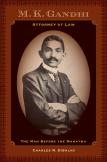Force Born of Love
On Sept. 29, 1888, 18-year-old Mohandas K. Gandhi, traveling alone from India, disembarked in England to begin his study of law at London’s Inner Temple. The rail-thin young man had only one goal in mind: to support himself and his pregnant young wife back home. Upon completing his legal education three years later, the aspiring barrister returned home, where he struggled to set up his practice. Still so shy he could barely speak in public, he was fortunate to encounter an Indian merchant in need of legal help with a business in South Africa. Gandhi promptly traveled to Natal. Soon he was representing other affluent Indian businessmen in Natal and later in the Transvaal. Inevitably, his practice brought him into conflict with the racist restrictions that directly affected his clients and pervaded all aspects of society.
Charles DiSalvo’s inspiring M. K. Gandhi, Attorney at Law: The Man Before the Mahatma demonstrates that Gandhi’s determined but frustrated efforts to achieve social change through litigation and petitions played a critical role in his eventual embrace of civil disobedience. Drawing on court records, speeches, letters, news accounts and Gandhi’s writings, DiSalvo painstakingly follows the barrister as he agitates for Indian civil rights. Given the racist milieu of Natal and Transvaal, his defeats were many, the successes few and temporary.
Gandhi personally felt the sting of racism. On his first appearance in court, the magistrate ordered him to remove his turban. (Gandhi politely refused.) During one of his evening walks, a police officer pushed and kicked him. An anti-immigrant mob badly beat him. Speaking with a new passion to his fellow Indians, he encouraged them to unite against anti-Indian laws and regulations. He placed his hope primarily in the courts, with disheartening results. Unsuccessfully he fought against a licensing act designed to put Indians out of business. He petitioned against segregated rickshaws, to no avail. His legal arguments won him nothing when he protested the South African Republic’s legislation denying citizenship to “any of the native races of Asia.” He fought against a measure designed to keep Indians from immigrating into Natal, mounted an assault against restrictions on Indian property rights, aided in the prosecution of corrupt racist officials and challenged legislation in the Transvaal requiring Asiatics to register and be fingerprinted. His relentless legal battles made him a powerful voice within the Indian community. But time and again, in courts and legislatures, his voice fell on deaf ears.
In 1904, Gandhi showed signs that he was considering a different path. Writing in the publication Indian Opinion regarding a piece of anti-Indian legislation, he suggested for the first time that Indians “must keep themselves absolutely cool and patient, still relying upon justice being ultimately done,” but they should “decline to pay any fines, and go to gaol” rather than comply with the offending act. By 1905, DiSalvo finds Gandhi so frustrated in the courts that he was “beginning to hate the very profession of which he was a part.”
In 1906, that frustration broke out into action. A Johannesburg regulation barred Indians from using regular tram cars. Gandhi arranged a test case in which an Indian deliberately defied the ordinance. The city authorities, however, sensing Gandhi’s tactic, declined to prosecute. This was civil disobedience in its infancy. DiSalvo observes that Gandhi “did not yet fully understand how to use mass disobedience as a point of leverage for engaging larger social, political and legal forces. He would learn soon enough.” By 1907, Gandhi was telling his audience that “true victory will be won only when the entire Indian community courageously marches to the gaol—when the time comes—and stays there as if it were a palace.” Gandhi himself was arrested, tried and convicted for refusing to carry the registration certificate required of Indians.
DiSalvo shows that Gandhi’s philosophy of satyagrapha (a term Gandhi preferred to “passive resistance”) grew in inverse proportion to his disappointment with the power of law to effect social change. If institutional injustice would not yield to litigation, Gandhi became convinced it would succumb to a “Force which is born of Truth and Love or non-violence.” “In a country where people suffer injustice and oppression and are denied their...rights, their real duty lies in suffering imprisonment....[T]he outcome of our campaign does not depend upon whether we win or lose in the Supreme Court.” In 1911, Gandhi decided to abandon the practice of law entirely. He surrendered the weapons of the courtroom for “the weapons of truth, soul-force, non-injury and courage,” as Martin Luther King, Jr. Gandhi’s spiritual heir, would describe in his Nobel Lecture of 1964.
M. K. Gandhi, Attorney at Law, offers a detailed and deeply thoughtful study of the ambiguous place of law in the life of a man who led millions of people to freedom.
This article also appeared in print, under the headline “Force Born of Love ,” in the February 8, 2016, issue.








